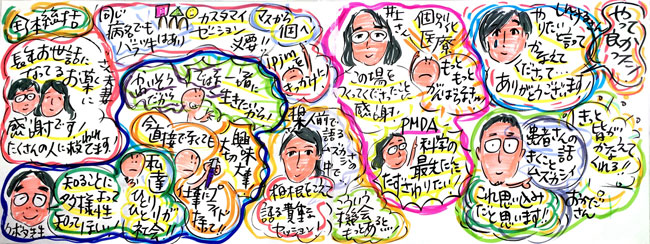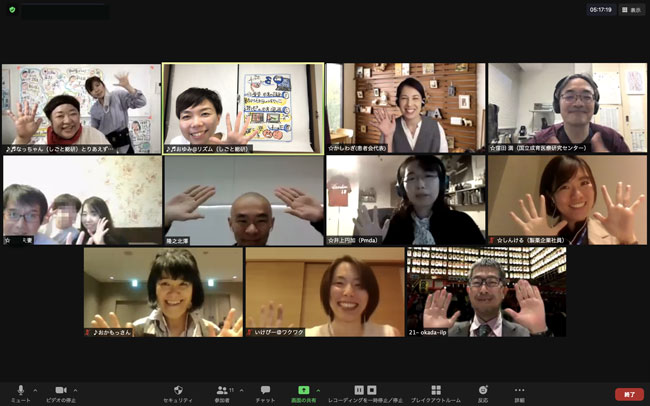Since 2017, COMPASS has held several workshops with many employees to spread internal awareness of the importance of being close to patients and worked on creating a Patient Journey Map (PJM) in collaboration with external organizations. The phrase “Patient Journey” expresses the process of the patient’s behaviors, thoughts, and emotions from the time they recognize their disease or condition until they visit a hospital and receive treatment; thus, it refers to “the journey of an individual with a disease.”
A PJM visualizes this journey, and the PJMs created through the COMPASS project extend beyond a mere record of patients’ disease information. They visualize the experiences and emotions of the patients and attempts to provide an opportunity for people who have never experienced the disease to feel what the patients feel to allow them to learn, first hand, about the disease from the patient perspective. Therefore, we modified the name to reflect this added experience resulting in “insightful PJM,” or iPJM.

Graphic Facilitation by Natsuko Yamada, SHIGOTO SOKEN INC.
As part of the COMPASS initiative, a poster presentation with a large panel display for iPJMs was held at the DIA Japan Annual Meeting* 2019 to share the concept of the iPJM with people outside of Daiichi Sankyo and promote the iPJM as a useful tool to understand patients and encouraging them to widely utilize it.
At the DIA Japan Annual Meeting 2020 (November 2020), due to the interest from the organizers and participants, we decided to plan a session to listen to a talk by a patient’s family and then create an iPJM based on it, rather than only showing iPJMs we had created beforehand like in 2019.
Although the DIA Japan Annual Meeting 2020 was originally planned as an on-site event, it was changed to online due to the COVID-19 pandemic. Therefore, we had to explore a way in which patients and other participants could interactively communicate with one another in a virtual environment.
After discussing options with the organizers and internally, we decided to plan a meeting in two parts: the first part as a session in which participants listened to and “felt” patients’ voices by creating an iPJM; and the second part as a session in which participants shared their opinions with one another to determine what they could do next.
In the second part, a representative of a patient family association associated with a specific disease area, a medical doctor from the National Center for Child Health and Development, a Pharmaceuticals and Medical Devices Agency (PMDA) reviewer, and an employee of a pharmaceutical company joined the session as panelists and shared their thoughts on patients from their respective standpoints. Participants were then asked to consider what they could do for patients from multiple perspectives: (1) patients themselves, (2) patients’ families, (3) doctors, (4) pharmaceutical companies, (5) regulatory authorities, and (6) society. And finally, all participants, including the panelists, discussed how each of them could contribute starting immediately—even from the very next day.
Further value of iPJMs emerges from the workshop
In the responses to the questionnaire to participants following the DIA Japan meeting, many people noted that through the sessions and discussions they became more aware of the specific challenges and difficulties that patients face, whereas they previously had tended to focus more on the disease itself.

Photo of the COMPASS members and participants taken after the second session.
In the responses to the questionnaire to participants following the DIA Japan meeting, many people noted that through the sessions and discussions they became more aware of the specific challenges and difficulties that patients face, whereas they previously had tended to focus more on the disease itself. One participant commented, “Through the discussions with participants from diverse backgrounds and perspectives, I was able to notice things that I wouldn’t have noticed in my daily work.” Comments like this one demonstrate the purpose of the event was achieved. We were also very pleased when a participant from another pharmaceutical company contacted us and said that she would like to try an initiative like COMPASS at her own company.
In addition, comments from the patients’ families included feedback such as, “This was the first time I experienced this type of session where a pharmaceutical company confronted our problems as if they were its own,” “I was glad to be listened to,” and “I would like to continue to help provide information in order to give others a better understanding of my disease.” Through our awareness of the need to create a positive atmosphere for frank discussion from each person’s own personal perspective, we believe that all participants felt comfortable speaking to each other on an equal footing.
Ultimately, this event was very meaningful because participants listened, felt, and tried to understand patients’ voices, along with being able to think together about how they can contribute from their own diverse perspectives. Compared to having created an iPJM ourselves internally, this interactive meeting seemed to have expanded the meaningfulness of the iPJM because our participation in the DIA enabled us to share our initiative with people from a number of external organizations.
We will continue our activities with a passion for innovation based on the patient-centric mindset we developed through initiatives such as COMPASS as well as based on our hope to support the daily lives of the patients, doing everything we can to help to save their lives.